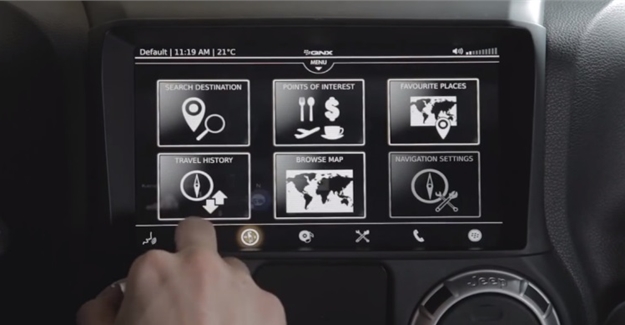BlackBerry has launched new automotive operating system. This OS can fuel BlackBerry’s vehicle presence by as much as tenfold, according to the head of the QNX automotive software division.
QNX® Software Development Platform 7.0 (QNX® SDP 7.0) is a 64-bit OS that builds on the proven reliability of QNX technology and raises the bar for security and performance in cars. At CES 2017, the technological capabilities of QNX SDP 7.0 will be demonstrated in BlackBerry QNX’s 2016 Jaguar XJ and 2017 Lincoln MKZ concept cars.
“With the push toward connected and autonomous vehicles, the electronic architecture of cars is evolving – from a multitude of smaller processors each executing a dedicated function, to a set of high performance domain controllers, powered by 64-bit processors and graphical processing units,” said John Wall, senior vice president and head of BlackBerry QNX. “To develop these new systems, our automotive customers will need a safe and secure 64-bit OS that can run highly complex software, including neural networks and artificial intelligence algorithms. QNX SDP 7.0 is suited not only for cars, but for almost any safety- or mission-critical application that requires 64-bit performance and advanced security. This includes surgical robots, industrial controllers and high-speed trains.”
QNX SDP 7.0 provides high performance and enhanced kernel-level security through an array of features, including microkernel architecture, file encryption, adaptive time partitioning, a high availability framework, anomaly detection, and multi-level policy-based access control. Featuring the next-generation QNX Neutrino® Realtime OS and QNX Momentics® Tool Suite, this reliable OS helps guard against system malfunctions, malware, and cyber attacks by implementing a multi-level, policy-driven security model that incorporates best-in-class security technology from BlackBerry. The OS also offers a safety pedigree proven by certification to ISO 26262 ASIL D (the highest level achievable) for automobiles and to IEC 61508 SIL 3 for industrial automation systems, and by compliance with IEC 62304 for life-critical Class III medical devices.
As automakers look to consolidate domain functions such as infotainment, telematics, and digital instrument clusters into a virtual cockpit controller, QNX SDP 7.0 provides a realtime OS that supports 64-bit for the ARMv8 and Intel x86-64 architectures, along with virtualization capabilities. QNX SDP 7.0 can help ensure that these automated systems perform all processes and actions reliably, within the pre-defined amount of time needed for successful and safe execution.
Must-See Concept Cars at CES – BlackBerry Booth 7029
BlackBerry QNX will unveil a Jaguar XJ concept car with a new digital cockpit design that combines the infotainment and instrument cluster functionality. It shows two operating systems running safely and securely on a single System-on-a-Chip (SoC) processor. BlackBerry QNX hypervisor software safely separates and isolates the infotainment system and graphics, meaning the infotainment system can safely re-start without affecting the instrument cluster. BlackBerry worked with Rightware Cluster UI to build the QNX Cluster graphics monitor that can detect failures in the safety system. The Jaguar XJ concept car also features BlackBerry’s QNX® Acoustics Management Platform (AMP) for clear high-definition in-car communication, active noise control, and engine sound enhancement.
BlackBerry QNX will also take the wrap off of its autonomous Lincoln MKZ concept car, showing QNX SDP 7.0 capabilities in action on Renesas’ CES test track (LVCC North Hall, Gold Lot). BlackBerry QNX worked with Renesas, the University of Waterloo and Polysync to develop the prototype vehicle that demonstrates Society of Automotive Engineers (SAE) Level 4 autonomous driving capabilities. Using LiDAR, radar, forward-facing cameras, global positioning systems (GPS) and inertial measurement units (IMU), the car can detect obstacles on the road, anticipate dangerous driving situations, and present warnings to avoid collisions to keep drivers and passengers safe. The QNX Platform for ADAS processes data generated from the sensors in realtime, and also records and plays back the data off-line for feature development and testing.
Also on display at BlackBerry’s CES booth is a 2017 Aston Martin Vanquish model that is now shipping with BlackBerry QNX’s latest in-vehicle infotainment software technology. The new infotainment system is the control center, seamlessly integrating audio, hands-free communication and vehicle status technologies into the cabin. It also has an upgraded satellite navigation system with a quicker address input, advanced traffic information, and support for Apple CarPlay.
BlackBerry Radar
BlackBerry will also showcase BlackBerry Radar, its secure end-to-end hardware and software asset tracking solution for the transportation and logistics industry. Radar provides more sensor readings, more often than any other solution on the market today. This allows customers to accurately monitor assets, manage yards, analyze utilization, measure efficiency, and reduce theft based on a near realtime view of the fleet.
Availability
QNX SDP 7.0 is the latest in a string of momentum updates BlackBerry has made in its software transformation, and comes less than a month after the company released a mobile-native, secure software platform for the Enterprise of Things, and two weeks after the unveiling of the BlackBerry QNX Autonomous Vehicle Innovation Centre. The beta release of QNX SDP 7.0 is available now for evaluation and product development. General availability is scheduled for Q1 2017.
Agencies/Canadajournal
 Canada Journal – News of the World Articles and videos to bring you the biggest Canadian news stories from across the country every day
Canada Journal – News of the World Articles and videos to bring you the biggest Canadian news stories from across the country every day



